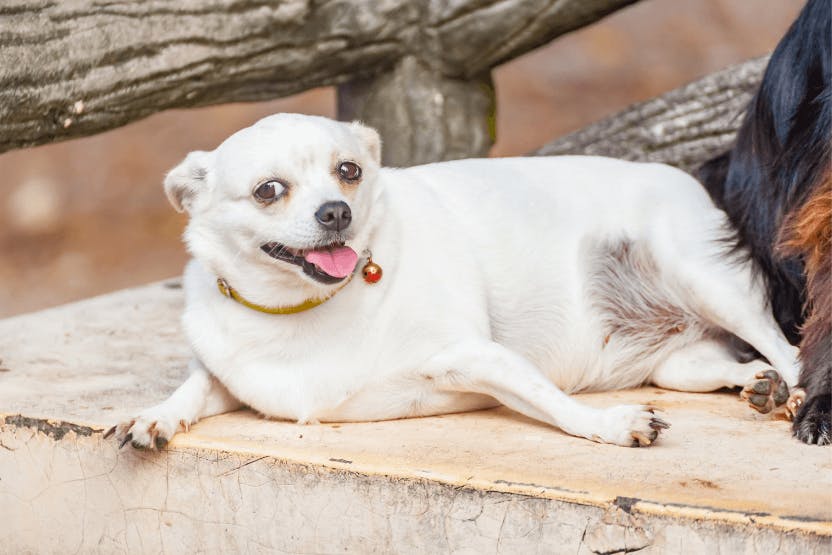In a
2018 survey, The Association for Pet Obesity Prevention found that more than 55% of American dogs are overweight or obese. Overweight dogs are 10% to 20% over their ideal, healthy weight. Dogs who weigh at least 20% over their healthy weight range are considered obese.
An overweight human is vulnerable to a variety of diseases, like diabetes. The same is true for pups. A
2019 study found that being overweight or obese can decrease a dog’s life expectancy by 2.5 years.
Whether you have a small, medium, or large dog, there’s a healthy weight for each. Would you like to know how to tell if your fur baby is at their healthiest weight, and if they’re not, what you can do about it? Let’s look at the facts.
How to determine if your dog is a healthy weight
Veterinarians use a scale to decide if a pup is at a healthy weight. The body condition score is determined by touch. By running your flat hand over the dog’s ribs and observing the dog’s waist and belly, you or your vet can tell how much excess fat they’re carrying.
The ribs should be easily palpable under the dog’s skin, without pressing too hard. Looking down on the dog from above, the waist should be clear and defined. And finally, looking at a dog’s belly from the side should show that it’s flat and doesn’t sag or bulge.
It can be difficult to judge whether your fur buddy is overweight because many dogs are portrayed in the media as being at a healthy weight when in reality they’re not. There are also misconceptions about how much and how often a dog should eat, as well as how many treats they can safely have.
It’s important to keep in mind that AKC weight standards for specific breeds may not match the healthy weight ranges for small, medium, and large dogs. AKC breed standards apply solely to purebred dogs and every individual is different.

Healthy weight range for small dogs

Healthy weight range for medium dogs
Some medium-sized dogs, like
Australian Shepherds, are extremely active, while others are more sedate. While this doesn’t affect the healthy weight for medium dogs criteria, these dogs may require more food to keep them well-nourished.

Healthy weight for large dogs
Remember though, these are all guidelines, and each dog will have a weight that is right for them.
What’s so important about maintaining your dog’s healthy weight?
As mentioned above, being overweight or obese increases your dog’s risk of developing certain conditions, including:
Overweight dogs have a higher risk of developing serious diseases.
If you suspect your dog is overweight or at risk, start searching for pet insurance today. Brought to you by Pet Insurer, Wag! Wellness lets pet parents compare insurance plans from leading companies like PetPlan and Embrace. Find the “pawfect” plan for your pet in just a few clicks!
Other factors that can affect your dog’s weight
Besides being ill, other factors come into play to make dogs overweight. For example, senior dogs can gain weight as they get older and are less active. Dogs who are in frequent, intense training may be getting too many “training treats.” It’s important to adjust intake to match activity levels and caloric needs.
Different breeds may be leaner than others. For example, within the healthy weight parameters,
Labrador Retrievers probably carry more weight as fat than other large dogs, like
Greyhounds or
Whippets. However, upon examination, the heavier Lab should still meet the physical dog condition criteria in the ribs, belly, and waist.
Studies performed over the past decade have challenged scientists' view of fat. Once considered to be a passive type of tissue with no specific activity, it’s now thought that fat secretes inflammatory hormones and creates oxidative stress on the body.
Obesity can now be thought of as a chronic, low-level inflammatory condition on its own. Just reducing your dog’s body fat can improve inflammatory conditions like
arthritis and
colitis.

How to help your dog to lose weight
Before you begin any new effort to help slim Fido down, be sure you get your veterinarian’s approval. They may suggest dietary changes or weight loss foods.
You control what your dog eats, as well as how much exercise your pup is getting. Helping your dog to
lose weight will keep them healthy and happy throughout their lives. Here are some tips to help with
weight management.
Reduce the overall calorie content of your dog’s diet
Just reducing the amount of dog food they’re getting puts the pup in danger of becoming malnourished. Instead, transition your dog to a lower-calorie kibble gradually. Your veterinarian can recommend the right
weight control food for your dog.
Cut down on treats like dog biscuits
Give only partial treats by breaking them up. Or try some low-calorie treats like
green beans,
broccoli, and cauliflower. Most dogs like fruit, too, but it’s important not to overdo fruit treats because of their high sugar content.
Up the activity level
Take your fur baby on walks, increasing the distance gradually to avoid injuries. Or hire a professional
dog walker with Wag! if you don’t have time to take one or two walks a day. Alternatively, take your pup for a swim in the ocean, pool, or a nearby lake. Most dogs love long games of fetch, as well.
Keep track of what your dog eats
Measure your dog’s meals, and keep a journal of what they’re eating to make it easier to adjust for the occasional treat. It's a good idea to weigh portions using a scales. Establish a schedule that both you and the pup can rely on. And limit between-meal snacks to about 10% of the total caloric intake.
Weigh your dog to monitor their weight-loss progress
Just as in humans, managing excess weight in dogs requires attention and commitment. Weighing them on a home scale or your vet's office every two to three weeks can help you keep track of your dog's progress and note if any adjustments need to be made. If they could, your furry friend would thank you for how much better they feel!


